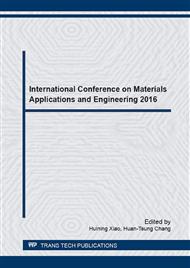p.38
p.43
p.49
p.53
p.58
p.63
p.71
p.79
p.84
Numerical Simulations and Experimental Investigations on Lead Iodide Single Crystals Growth
Abstract:
Lead iodide (PbI2) single crystal for room temperature radiation detectors are mainly produced by Vertical Bridgman (VB) method. Computer simulations of the VB method could be an effective tool to optimize the growth process and reduce the production costs. In the present study, we applied the general Computational Fluid Dynamics (CFD) code to solute the quasi-static two-dimensional (2D) axisymmetric model of the VB ampoule filled with PbI2 melt and direct the growth of high quality PbI2 single crystals with a diameter of 15 mm. The thermal conductivity and latent heat generation during the crystallization is considered in the numerical model. We focused on the crystal-melt interface deflection. The results demonstrated that the ampoule with 15 mm diameter is better than that of 30 mm. The experimental results showed that the single crystal with 15 mm diameter exhibited high electrical resistivity (109 Ωcm).
Info:
Periodical:
Pages:
58-62
Citation:
Online since:
September 2016
Keywords:
Price:
Сopyright:
© 2016 Trans Tech Publications Ltd. All Rights Reserved
Share:
Citation:


